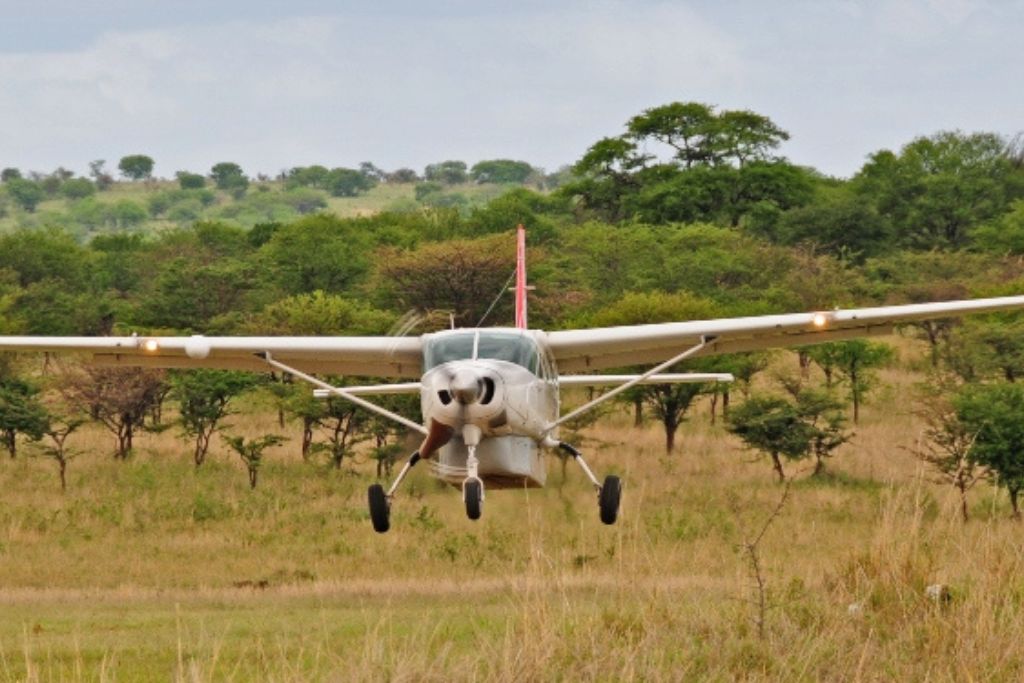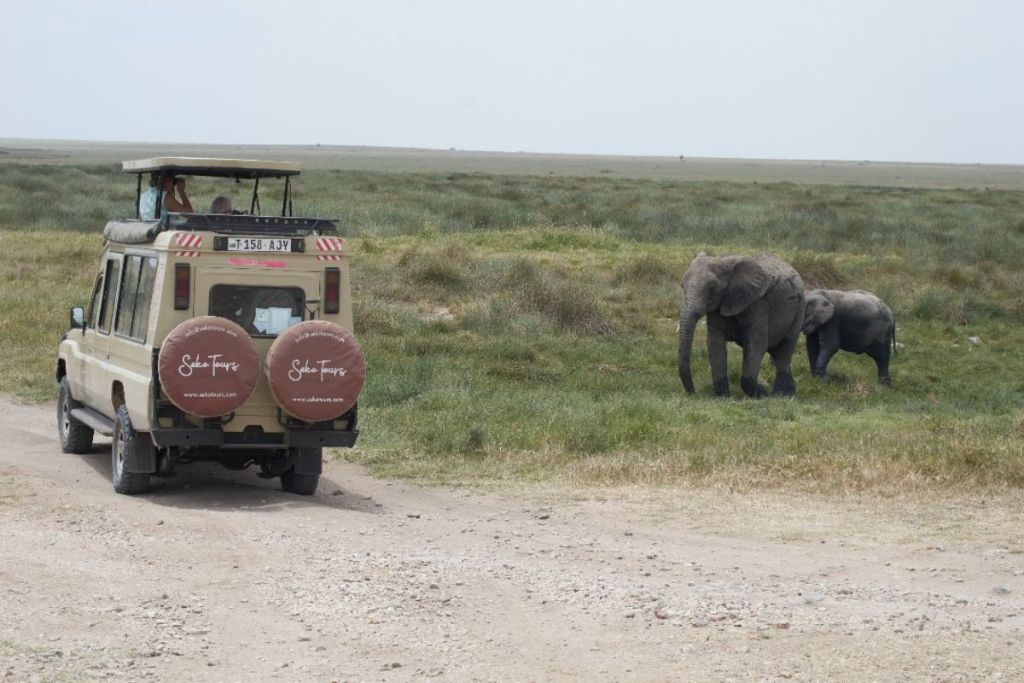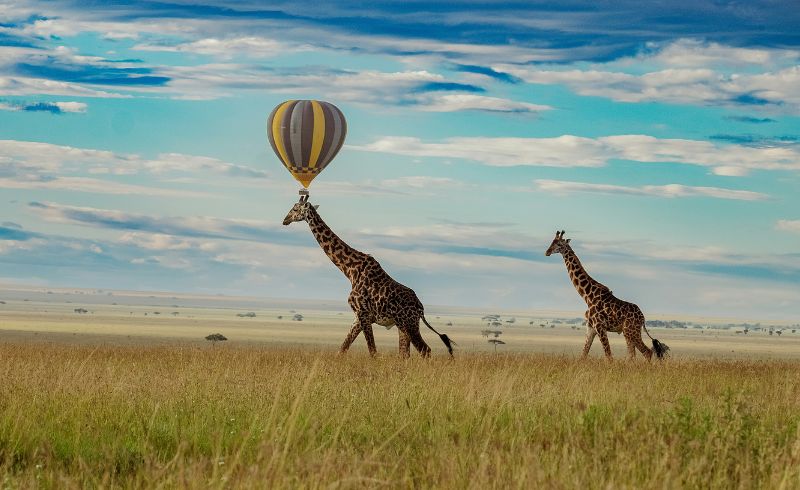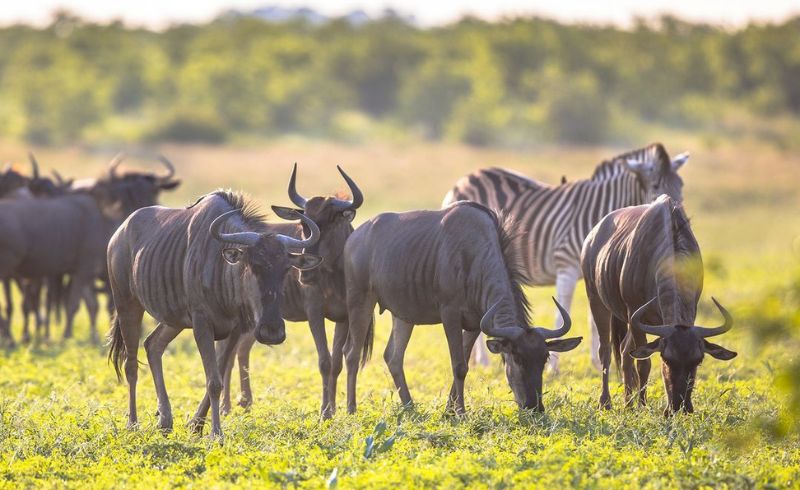Serengeti National Park
Serengeti National Park - Home to the Great Migration
Serengeti National Park, located in northern Tanzania, is one of the most famous wildlife conservation areas in the world. Known for its vast plains, iconic landscapes, and the incredible Great Wildebeest Migration, this UNESCO World Heritage Site attracts visitors from across the globe.
The word “Serengeti” comes from the Maasai language, meaning “endless plains,” perfectly describing the park’s sweeping grasslands that seem to stretch forever. Whether you’re an adventure seeker, a nature lover, or a photographer, Serengeti promises an unforgettable experience.
Serengeti National Park isn’t just about wildlife—it’s also a place of profound natural beauty and tranquility. The park’s golden savannahs are dotted with ancient acacia trees and dramatic granite kopjes, creating an iconic African landscape that has inspired countless travelers and filmmakers. As the sun sets over the horizon, painting the sky with hues of orange and pink, you’ll understand why Serengeti is considered one of the most magical destinations on Earth.
Highlights
- Witness the iconic Great Wildebeest Migration
- Quintessential savannah landscape with acacia woodlands and rocky kopjes
- Watch the sunrise on a hot-air balloon safari
- Stay in ultra-luxury accommodation or mobile tented camps
- Sensational game viewing and safari activities, including night drives
- The Big Five: Lions, leopards, elephants, buffalo, and rhinos are all found here. The park is particularly famous for its large lion population.
- Cheetahs: Watch these sleek predators sprint across the plains.
- Herbivores: Giraffes, zebras, gazelles, and wildebeests graze in harmony, creating a vibrant ecosystem.
- Birdlife: From the colorful lilac-breasted roller to ostriches, Serengeti is a birdwatcher’s haven.
Incredible Wildlife You’ll Find in Serengeti National Park
Serengeti is home to an astonishing range of wildlife, hosting over 70 mammal species and 500 bird species. Here’s a glimpse of what you can expect:












Every corner of the park reveals a new discovery, whether it’s a lion basking in the sun or a herd of elephants moving majestically through the savannah.
Serengeti Safari Packages
Discover our most popular safaris
Planning your Serengeti adventure is easy with a variety of safari packages tailored to meet different preferences and budgets. Whether you’re seeking luxury, family-friendly experiences, or a quick getaway, Serengeti has options to suit every traveler:
The Stunning Landscape of Serengeti
Serengeti National Park spans over 14,750 square kilometers and offers diverse terrains that cater to different wildlife and vegetation. Its three main regions each have unique features:
Central Serengeti (Seronera)
The Central Serengeti, often referred to as Seronera, is the bustling heart of the park. This region is characterized by a mix of open grasslands and riverine forests, making it a hotspot for wildlife activity. Seronera is particularly known for its high population of big cats, including lions, leopards, and cheetahs, which can be seen year-round. The Seronera River, a lifeline for the region, attracts many animals during the dry season, offering visitors unparalleled opportunities to spot predators and their prey in action. This area’s accessibility and abundant wildlife make it a favorite among safari-goers, ensuring a thrilling experience at any time of year.
In addition to its wildlife, Central Serengeti is also home to kopjes, or rocky outcrops, that provide shelter for animals like lions, leopards, and hyraxes. These dramatic rock formations not only offer a unique landscape but also serve as excellent vantage points for predators surveying their surroundings. The combination of wildlife density and scenic beauty makes Seronera a must-visit destination within the park.
Northern Serengeti
The Northern Serengeti is a remote and less crowded region of the park, stretching toward the border with Kenya and the neighboring Maasai Mara Reserve. This area is best known for the dramatic Mara River, which plays a central role in the Great Wildebeest Migration. Every year, thousands of wildebeests, zebras, and gazelles cross the crocodile-infested waters of the Mara River in a perilous journey that showcases nature’s raw drama. Visitors who arrive during this period witness one of the most iconic wildlife spectacles in the world.
Beyond the migration, the Northern Serengeti is home to diverse wildlife, including elephants, giraffes, and an array of bird species. The region’s varied landscape of rolling hills and open woodlands provides a serene yet adventurous setting for safari enthusiasts. The quieter atmosphere in this part of the park allows for a more intimate and immersive experience with nature.
Southern Serengeti
The Southern Serengeti is the park’s lush, grassy expanse that comes to life during the rainy season, making it an essential part of the ecosystem. From December to March, this area becomes the calving ground for wildebeests, with thousands of newborns arriving within a short period. This phenomenon not only draws herds of herbivores but also attracts predators like lions, cheetahs, and hyenas, who take advantage of the abundance of vulnerable prey.
The wide, open plains of the Southern Serengeti offer unobstructed views, making it one of the best places for spotting large herds and predator-prey interactions. The area is particularly significant for its role in the Great Wildebeest Migration, as it provides the grazing and birthing grounds necessary for the survival of the herds. Visitors to the Southern Serengeti during this time can witness the circle of life in its most raw and unfiltered form.
Interesting Facts about Serengeti National Park
Serengeti National Park stands as a captivating testament to the wonders of the natural world, drawing visitors from across the globe to its mesmerizing landscapes. Beyond its reputation as one of the most popular wildlife attractions globally, the park offers a profound connection to history.
As herds of wildebeest gracefully traverse the Serengeti valley, juxtaposed against the remnants of German forts from the First World War, a unique narrative unfolds. This juxtaposition creates an unforgettable spectacle, where the animal kingdom intersects with human history.
The vast expanse of the Great Rift Valley, adorned with extinct volcanoes and mountain ridges seamlessly merging into expansive plains, paints a picturesque panorama that extends towards the horizon in the West. These plains gradually transform into tropical forests, eventually leading to the shores of Lake Victoria, one of the largest lakes on Earth.
The harmonious coexistence of these diverse elements, both natural and historical, creates an enchanting experience that undoubtedly leaves visitors with a profound sense of magic and awe.
Why visit Serengeti National Park
The Great Wildebeest Migration
The Great Migration happens every year when about 1.5 million animals like wildebeest, zebras, and gazelles come together in one big group and move through the park to find fresh grass. It’s the biggest group of large animals in the world. They start in the south and move in a circle toward the north, with the most exciting part being when they cross the Grumeti and Mara rivers.
THINGS TO DO
Top Activities in Serengeti National Park
Serengeti National Park is not just a place to see animals; it’s a destination that offers many exciting activities for all kinds of travelers. Whether you are interested in watching wildlife up close, exploring the park’s vast landscapes, or learning about the local culture, Serengeti has something special for everyone. Here are the top activities to experience during your visit:
Game Drives
One of the most popular activities in Serengeti is going on a game drive. This is where you get into a 4×4 safari vehicle and drive around the park, looking for animals. It’s an exciting way to get close to wildlife while staying safe. The best time to go on a game drive is early in the morning or in the evening, when animals are most active. In the early morning, you might see lions hunting, while in the evening, you can spot animals returning to their resting spots.
On a game drive, you can see the Big Five (lions, leopards, elephants, buffalo, and rhinos), cheetahs, giraffes, zebras, and many more animals. Game drives are led by experienced guides who know the best spots to find animals, making this a top activity for anyone visiting Serengeti.
Learn More about Game Drive
Hot Air Balloon Safari
If you want a unique way to see Serengeti, a hot air balloon safari is a must. This activity takes you high above the park in a hot air balloon at sunrise, giving you a bird’s-eye view of the endless plains, rivers, and wildlife below. As you float above the park, you will see herds of wildebeests, zebras, and elephants moving across the land. The peaceful, silent flight allows you to experience Serengeti from a completely different perspective, and the views are truly breathtaking.
Many people consider a hot air balloon safari to be a once-in-a-lifetime experience. After the flight, you are often treated to a special breakfast in the wild, adding even more magic to your Serengeti adventure.
Learn More about Hot Air Balloon Safari
Walking Safaris
For those who want a more personal connection with nature, a walking safari is a fantastic option. This activity lets you explore the park on foot with an experienced guide. Unlike a game drive, a walking safari allows you to see the smaller details of Serengeti’s wildlife and plants. You might learn about the different trees and plants that animals use for food and shelter. You may also spot smaller animals, like insects and birds, that you might miss while in a vehicle.
A walking safari offers a deeper understanding of the Serengeti ecosystem. Your guide will explain how the animals live, hunt, and interact with each other. This activity gives you the chance to truly connect with the land and wildlife of Serengeti in a way that is different from a typical game drive.
Learn More about Walking Safari
Birdwatching
Serengeti is a paradise for bird lovers, with over 500 bird species calling the park home. Whether you’re an experienced birdwatcher or just someone who enjoys seeing colorful birds, Serengeti is the place to be. Some of the most famous birds you can spot here include the secretary bird, the Kori bustard (the world’s heaviest flying bird), and flamingos that gather around the park’s lakes.
Birdwatching in Serengeti is especially exciting during migration periods when thousands of birds pass through the park. Whether you’re in the open plains or near the rivers and lakes, you’ll have the chance to spot a wide variety of species, from small songbirds to large raptors. A birdwatching tour with a knowledgeable guide can help you identify different species and understand the role they play in Serengeti’s ecosystem.
Learn More about Birdwatching
Cultural Visits
Serengeti is not just about animals; it’s also about the people who live in the region. A cultural visit to nearby Maasai villages gives you the chance to learn about the Maasai people, their traditions, and their way of life. The Maasai are a semi-nomadic community known for their colorful clothing, beadwork, and their deep connection with the land and wildlife of Serengeti.
During a cultural visit, you can learn about Maasai customs, like their famous jumping dance, and explore their traditional homes, called bomas. The Maasai also share how they coexist with the wildlife in Serengeti, using traditional knowledge to live in harmony with the animals and the environment. These visits provide a deeper understanding of the local culture and are an important part of your Serengeti experience.
Learn More about Cultural Visits
These activities make a trip to Serengeti National Park unforgettable. Whether you’re on a game drive, in a hot air balloon, walking through the plains, birdwatching, or learning from the Maasai people, Serengeti offers adventures that will stay with you forever.
When is the Best Time to Visit Serengeti National Park?
Serengeti is a year-round destination, but the experience varies depending on the season:
Dry Season (June to October)
- Witness the iconic Great Wildebeest Migration
- Best time for the Mara River crossing during the migration.
Wet Season (November to May)
- The landscape is lush and green, with fewer tourists.
- The calving season (January to March) brings newborn wildebeests and predators on the hunt.
Each season offers unique experiences, so your visit depends on what you want to see and do. Learn more about the best time to visit Tanzania to plan your perfect safari adventure
Where to Stay in Serengeti National Park
Whether you prefer luxury or a more authentic camping experience, Serengeti offers a wide range of accommodations:
How to Reach Serengeti National Park
Reaching Serengeti is straightforward with several options:

By Air
Flights are available from major airports like Kilimanjaro International Airport or Arusha Airport to airstrips within Serengeti, such as Seronera and Kogatende, ensuring a quick and seamless journey.

By Road
From Arusha, it’s about an 8-hour drive to the park’s main gate. Many travelers combine Serengeti with other parks in the Northern Circuit, like Ngorongoro Crater and Lake Manyara.
Feature Travel Tips
See Our Basic Tanzania Travel Info
Popular questions about Serengeti National Park
Our packages usually include accommodation, meals, transport, game drives, park fees, and a professional guide. Flights, visas, and personal expenses are typically excluded unless stated otherwise.
Yes, we specialize in tailor-made safaris. You can adjust destinations, activities, and accommodations to match your needs.
The best time is during the dry season (June to October) when wildlife is easier to spot. However, the Wildebeest Migration is spectacular between January and March or July and September.
Tanzania is a safe and friendly destination. Our team ensures you are well taken care of throughout your journey.
Absolutely! Many travelers end their safari with a relaxing stay on Zanzibar's beautiful beaches. We can arrange everything for you.
We accept bank transfers, credit cards, and mobile money. Payment details will be shared during the booking process. Read More here
We have a cancellation policy in place. Refunds depend on how close to the travel date you cancel. We recommend travel insurance for added protection. Read More here
Pack light clothing in neutral colors, comfortable walking shoes, a hat, sunscreen, binoculars, and a camera. Don’t forget insect repellent and any personal medications.
Yes, we have family-friendly safari options with activities and accommodations suitable for children.
Of course! Just let us know your dietary needs in advance, and we’ll ensure you’re well taken care of.
We use 4x4 safari vehicles with pop-up roofs for excellent wildlife viewing and photography. They are spacious and well-maintained.
Most visitors need a visa to enter Tanzania. You can get it online or upon arrival. We’re happy to assist with any questions.
Yellow fever vaccination is required if you’re arriving from a country with a risk of yellow fever. Malaria precautions are also recommended. Consult your doctor for advice.
It’s best to book 6-12 months in advance, especially during the peak season, to secure your preferred itinerary and accommodation.
Yes, Tanzania is one of the best places to see the Big Five: lions, leopards, elephants, buffaloes, and rhinos. Popular parks like Serengeti and Ngorongoro Crater offer great chances to spot them.
If your question is not listed, please contact us from here.


